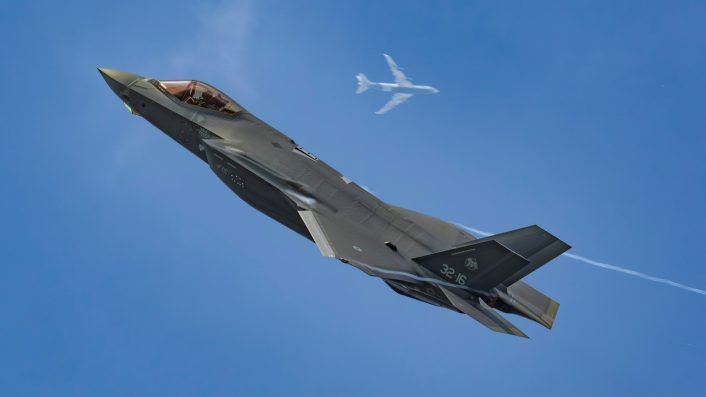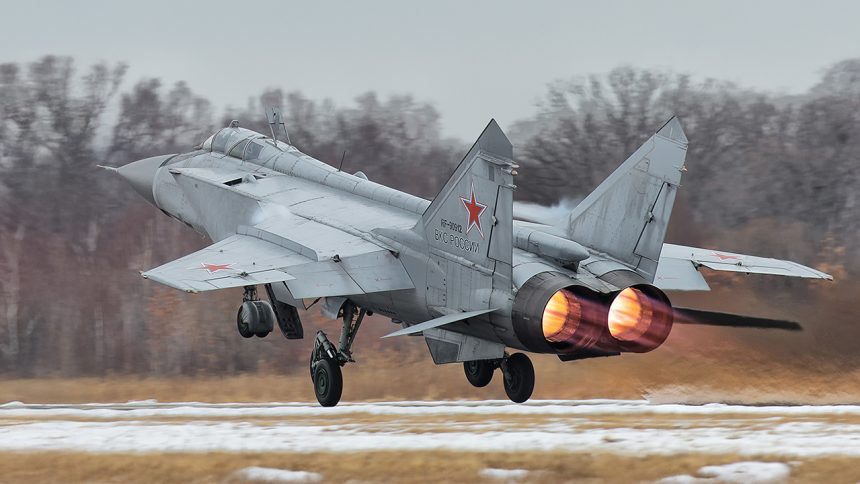Three Russian MiG-31 Foxhound fighters violated Estonian airspace, prompting the scramble of two Italian F-35s to intercept them.
Three MiG-31 Foxhound fighters of the Russian Aerospace Forces entered Estonian airspace on Sept. 19, 2025. Two F-35A Lightning II of the Italian Air Force currently deployed to Ämari Air Base, Estonia, to support NATO’s Baltic Air Policing mission, were scrambled to intercept them.
The Estonian government stated that three Russian Foxhounds entered Estonian airspace near Vaindloo Island today, remaining inside for about 12 minutes.
According to the initial reports, the fighters initially flew on a course toward Estonia’s capital Tallinn before circling within Estonia’s airspace, where they were eventually intercepted.
“Earlier today, Russian jets violated Estonian airspace. NATO responded immediately and intercepted the Russian aircraft,” said NATO spokesperson Allison Hart to media outlets. “This is yet another example of reckless Russian behaviour and NATO’s ability to respond.
Earlier today, Russian jets violated Estonian airspace. NATO responded immediately and intercepted the Russian aircraft. This is yet another example of reckless Russian behaviour and NATO’s ability to respond.
— NATO Spokesperson (@NATOpress) September 19, 2025
According to the Estonian media, the aircraft did not have flight plans and their transponders were turned off. At the time of the violation, the aircraft also did not have two-way radio communication with Estonian air traffic control, a spokesman for the Estonian Defence Forces said.
Taavi Karotamm, the head of the Estonian Defence Forces’ press department, told ERR that the planes flew parallel to the Estonian border from east to west and entered Estonian airspace to a depth of less than 10 kilometers.
The Russian MiG-31s were first escorted by Finnish Air Force fighters and then by the Italian Air Force F-35 fighters which escorted them out of Estonian airspace towards the Kaliningrad region, said Karotamm.
At the time of writing, NATO Air Command has not released any official statement about the incident. NATO spokesperson said the Russian aircraft were intercepted and according to the Estonian media, they were also escorted outside Estonia’s airspace, so there are chances some photographs of the close encounter will be released. It is also possible some images will be disclosed by the Russian side. We’ll see.
Meanwhile, several NATO AEW (Airborne Early Warning) assets could be tracked as they surveilled NATO airspace in the Baltic region and on the Eastern Flank.
Followed shortly after by the Italians over Lithuania Estonia.
🇮🇹 IAM1495 is G550 CAEW MM62293 #33FDC2 pic.twitter.com/Hqw1FniWVB
— Evergreen Intel (@vcdgf555) September 19, 2025
The latest one, marks the fourth violation of Estonian airspace by Russia so far this year.

Following the incident, Estonia said it had summoned Russia’s chargé d’affaires in Tallinn, lodging a protest. The European Union’s High Representative for Foreign Affairs and Security Policy and Vice-President of the European Commission Kaja Kallas called the episode “an extremely dangerous provocation.”
Interestingly, the MiG-31s were also intercepted by the Swedish Air Force Gripens.
Following a violation of Estonian air space, Swedish JAS 39 fighters intercepted and monitored three Russian MiG-31 fighter jets over the Baltic Sea today. Sweden is always ready to ensure the safety, security and integrity of our airspace together with our allies.#WeAreNATO pic.twitter.com/gpTbmngiKc
— Försvarsmakten (@Forsvarsmakten) September 19, 2025
The incursion of the three Russian fighters into Estonian airspace comes a week after Russian drones intruded into Polish and Romanian airspaces. According to Defense News, quoting official sources, three drones were shot down by NATO aircraft, while at least eight others crashed inside Poland. Fortunately, there were no casualties, although debris was recovered in several locations.
The drone incursion in Poland prompted a response by NATO, which launched a new mission called Eastern Sentry.
NATO Baltic Air Policing
Anyway, as explained in details previously here at The Aviationist, NATO BAP mission is dedicated to safeguarding the airspace over Estonia, Latvia, and Lithuania, three countries that joined the Alliance in 2004 but do not have their own air combat fleets.
Under the Baltic Air Policing (BAP) mission, NATO allies rotate fighter detachments and support personnel to the region for tours typically lasting about four months. The deployed contingents operate mainly out of Šiauliai Air Base in Lithuania and Ämari Air Base in Estonia, maintaining a constant Quick Reaction Alert (QRA) posture. Aircraft on QRA can be scrambled within minutes to intercept, identify, and if necessary escort, any unknown or unauthorized aircraft approaching NATO airspace. Beyond its operational function, the BAP mission serves as both a deterrent to potential aggressors and a tangible demonstration of NATO’s commitment to safeguard its eastern flank.
While occasional violations of Baltic airspace were reported in previous years, the frequency has grown recently, suggesting that Russia is deliberately testing NATO’s air defense readiness and response times. These repeated incursions underscore the importance of maintaining a robust and credible QRA presence in the region.
While 12 minutes from detection to scramble might sound like a long time, it’s actually not. Unless fighters are already airborne on a CAP (Combat Air Patrol), which they normally are not under standard NATO peacetime Quick Reaction Alert procedures, it takes a few minutes to issue the scramble order and additional time for the pilots to launch. When you also factor in the flight time to the intercept point, it becomes clear that air defense is far more complex than one might assume.
Supporting BAP is BALTNET (Baltic Air Surveillance Network), a trilateral initiative run by Estonia, Latvia, and Lithuania. The system links radar sites and Control and Reporting Centers (CRCs) across the three nations, creating a shared, real-time air picture that can be relayed seamlessly to NATO command structures. This integration ensures that any suspicious activity is detected at the earliest stage, allowing fighter jets to be scrambled without delay.
BALTNET’s main CRCs include CRC Tallinn (callsign Lighthouse) in Estonia, CRC Lielvārde (callsign Amberland) in Latvia, and CRC Karmėlava (callsign Galaxy) in Lithuania. These facilities operate around the clock, continuously tracking aircraft movements and coordinating with the Combined Air Operations Centre (CAOC) in Uedem, Germany. Their contribution is vital, given the Baltic States’ limited indigenous air defense capabilities.
Ultimately, BALTNET and the BAP detachments form an integral part of NATO’s Integrated Air and Missile Defense System (NATINAMDS). By pooling resources, sharing radar data, and ensuring rapid reaction, they guarantee that the Baltic skies remain protected 24/7 against potential threats.
Baltic Eagle III
Four Italian F-35A aircraft arrived at Ämari Air Base, Estonia, for Operation Baltic Eagle III, on Jul. 25, 2025. Their deployment was publicly trackable on aviation monitoring websites such as AirNav RadarBox, where enthusiasts and analysts could observe the planned transit and arrival of the aircraft.
The unit currently deployed to Ämari Air Base in Estonia is designated as Task Force Air – 32nd Wing. It comprises aircraft and mission-essential personnel drawn from the 32nd Stormo (Wing), based at Amendola Air Base, as well as a support and operations contingent from the 6th Wing, based at Ghedi Air Base.
A handover ceremony on Aug. 1, 2025, marked the formal transfer of responsibility from the Portuguese Air Force to the Italian Air Force. The Italian fifth-generation fighters, at their second BAP mission, are scheduled to remain in Estonia for four months, to safeguard the airspace of Estonia, Latvia, and Lithuania, operating under NATO command and on QRA status.

The 2015 shootdown of a Russian Su-24
After the news broke, many social media users immediately recalled the 2015 shootdown of a Russian jet by the Turkish Air Force, often citing that “it took only 17 seconds.” They were referring to the now infamous incident that occurred on Nov. 24, 2015, at 09.25LT, when a Russian Su-24M2 Fencer (bort number 83) was downed by a Turkish Air Force F-16 near the Turkey–Syria border. According to Ankara, the Russian aircraft, one of the twelve deployed at Khmeimim Air Base near Latakia in northwestern Syria, had penetrated Turkish airspace to a depth of 2.19 km (1.36 miles), remaining inside for just 17 seconds.
Can that episode be compared to today’s intrusion over Estonia? The answer is no.
The 2015 shootdown came against the backdrop of escalating tension between Turkey and Russia, fueled by repeated airspace violations in the preceding weeks. On Oct. 3 and 4, 2015, Russian Su-30SM and Su-24 jets had crossed into Turkish airspace over the Hatay region despite, as NATO later reported, “clear, timely and repeated warnings” by Ankara. In that case, Turkish F-16s on QRA were scrambled to identify the intruders, which eventually turned back. Still, the situation was already serious: one of the Russian Su-30SMs reportedly maintained a radar lock on the Turkish fighters for 5 minutes and 40 seconds. Moscow dismissed the episode as a “navigation error,” but Ankara responded by declaring that any further violation of its sovereign airspace would be met with lethal force, just as it had done in the past against Syrian aircraft, including a MiG-23 and a Mi-17 helicopter.
That warning was not idle. On Nov. 24, 2015, the Su-24 was engaged and shot down, with Turkish officials later claiming the aircraft had ignored 10 radio warnings issued over 5 minutes before the missile launch (a version later confirmed by US officials too).
The contrast with today’s events in the Baltic is stark: different circumstances, different rules of engagement, and different strategic context. The 2015 case was the culmination of repeated, deliberate provocations along a contested border, where Turkey had already made its red lines clear. Today’s Estonian airspace violation, while serious, occurred under the framework of NATO’s Baltic Air Policing mission, a peacetime deterrence posture designed to intercept and identify intruders, not to escalate with the use of force unless absolutely necessary.









